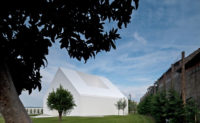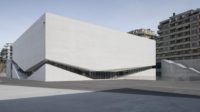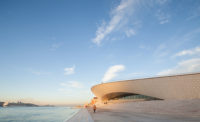EDP Headquarters by Aires Mateus
Lisbon, Portugal

Two glazed ramps at the front and rear of the EDP building link the office’s twin towers.
Photo © doublespace photography

The complex faces south onto the waterfront, with the city of Lisbon rising behind it.
Photo © doublespace photography

Photo © doublespace photography

Photo © doublespace photography

Covered bridges look out onto a central plaza between the two shafts.
Photo © doublespace photography

A double-height balcony on the east tower offers views of the Lisbon harbor.
Photo © doublespace photography

The sun creates dramatic stripes of light and shadow through the latticework over the central plaza.
Photo © doublespace photography

Image courtesy Aires Mateus and Associates

Image courtesy Aires Mateus and Associates

Image courtesy Aires Mateus and Associates

Image courtesy Aires Mateus and Associates











Architects & Firms
Already a landmark on Lisbon’s skyline, the new headquarters of Energias de Portugal (EDP) was born out of the company’s desire to achieve certain goals: increased efficiency, higher productivity, and improved communication between its employees and the public. With 16 offices scattered around the Portuguese capital, the 40-year old energy company decided to concentrate administrative departments into a single building in Aterro da Boavista, a burgeoning area of the city’s once-industrial riverfront.
In 2008, EDP launched an invited competition, not only for the architectural design of the headquarters but also for the master plan of its surroundings. While the atelier of Carrilho da Graça won the planning commission, Lisbon-based architects and brothers Francisco and Manuel Aires Mateus developed the winning proposal for the architectural design. Their solution thoughtfully addresses the brief as well as responding to the riverfront location as it continues to develop housing and tourism and restore industrial buildings.
Additional Content:
Jump to credits & specifications
Manuel explains the reasoning behind the project as if it could not have been done any other way. First, to avoid blocking the connection to the city on the north and the river on the south, he and Francisco placed all the large programmatic elements underground, including parking, the entrance lobby, and an auditorium. The workspaces are grouped in two slender eight-story towers. To emphasize the sense of flow, transparency, and continuity at ground level, the team created a public square shaded by a lattice-like structure linking the east and west towers. Pedestrian bridges gently lift above the square to connect the towers on the site’s southern and northern edges. Finally, the desire for open, flexible offices, with light and views for EDP’s corporate and administrative departments, led the architects to create a glass facade supported by a complex structure of steel columns coated in white prefabricated GRC elements. These vertical finlike forms both shade the interior and lend the building its distinctive, ever-changing appearance.
The architectural design shows an apparently effortless rationality underpinning the building’s steel and concrete structure. Yet the rigorous calculations were as much cultural as mathematical. In order to reaffirm EDP’s profile as a supporter of the arts, the company invited several internationally renowned architects and designers to execute the interiors. Marcio Kogan of Studio MK27 in São Paulo was responsible for the reception area as well as the workspaces; London-based Universal Design Studio took on the communications lounge, to be completed in the future; Shanghai-based Neri & Hu designed the business lounge, now under construction; British designer Jasper Morrison is commissioned to do the restaurant soon to be built; and Miguel Vieira Baptista of Lisbon masterminded the foyer cafeteria, already open to the public. In addition EDP has placed artworks throughout the public areas.
Employees and visitors arriving on foot descend to the entrance foyer via two symmetrical staircases located in the plaza beside each tower. There they find the reception area, the auditorium, a public cafeteria, meeting rooms, a gym, and—eventually—the business and communications lounges. From the first to the seventh story, the towers’ flexible open plan spurred MK27 to provide modular furniture that can easily be rearranged according to the needs of each department. In some cases, rows of open desks are divided by low storage furniture; in others, larger workstations allow impromptu meetings. Private offices for department heads, meeting rooms, and smaller rooms for more sensitive conversations also appear on every floor. Yet the main characteristic of EDP’s new interpretation of workspace gives center stage to areas that were once hidden at the back of the offices. Pantries, lounge areas, work cafés, and the outdoor balconies—where employees can take a break, confer in groups, or conduct meetings—have received prominent locations. Standing desks, and picnic-style tables, as well as lounge chairs, are part of the office landscape.
While not yet “at the level of businesses like Google,” as EDP’s real-estate administrator and engineer José Santos Pires puts it, the company had a very clear goal of changing its own office culture through the reorganization of the workplace. To help the staff break away from rigid policies that previously determined in-office behavior, the design offers myriad new informal settings. Leaving the desk for a midmorning snack or working on the terrace encourages increased communication among employees. Surprisingly, noise levels due to office chatter have dramatically decreased in response to the open-space environment.
Workplace organization had to be adapted to EDP’s particular needs and objectives as well as taking into account its conservative past, since the management feared radical changes would undermine efficiency and productivity. Therefore, the top floors of each tower, home to the company’s executive, general, and supervisory boards, abandon the open plan. Instead, large private offices, sumptuously furnished, and lounge areas—plus generously sized board meeting rooms—reflect ties to the old ways of doing things.
Because of this incremental approach, employees have already adapted with relative ease to the new environment. Now, as team leaders actively encourage staff to take advantage of the wide range of task spaces available, the architecture and design of its numerous facilities can truly begin to contribute to the company’s aspirations.
PeopleArchitect: Aires Mateus Personnel in architect's firm who should receive special credit: Authors: Manuel Aires Mateus, Francisco Aires Mateus
Frederico Valsassina, José Maria Assis
Engineers: AFA Consult
General contractor: Mota Engil / HCI
Photographer: doublespace photography
|
ProductsStructural System White concrete Manufacturer of any structural components unique to this project: Martifer
Exterior Cladding Metal/glass curtain wall: Martifer aluminios Moisture barrier: Mapei, Basf
Windows Metal frame: Martinfer Aluminios
Glazing Glass: Saint gobain
Doors Metal doors: Dictator Fire-control doors, security grilles: Porseg Special doors: Crawford
Interior Finishes Acoustical ceilings: Castelhano-Ferreira Suspension grid: Falfer Demountable partitions: Divilux Resilient flooring: Silvas Carpet: decoresse/vorwerk
Lighting Interior ambient lighting: Flos, Arcluce, Exporlux, Disano, Viabizzuno Exterior: Arquiled
Conveyance Elevators/escalators: Kone Accessibility provisions: Senda
Energy Energy management or building automation system: EDP Photovoltaic system:EDP |

















